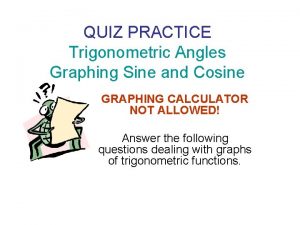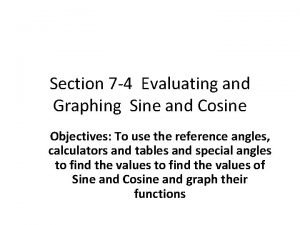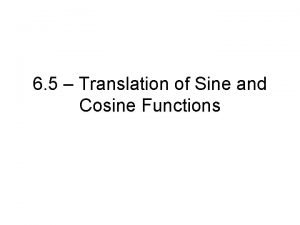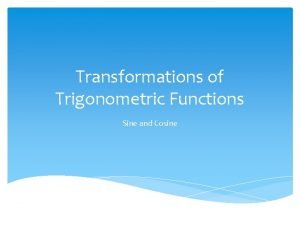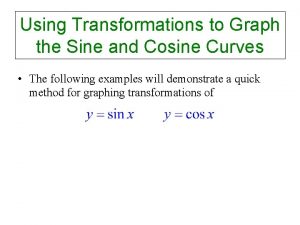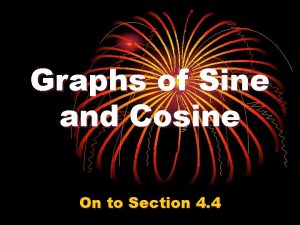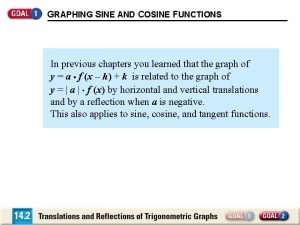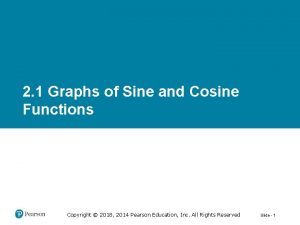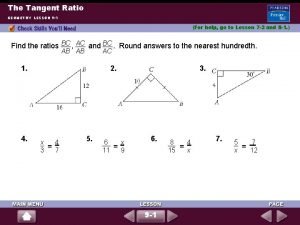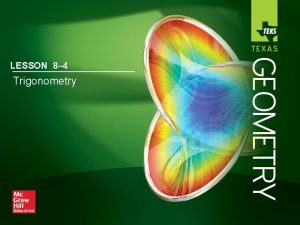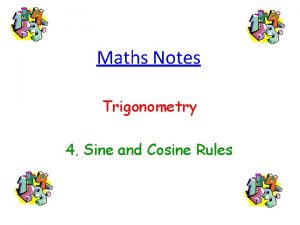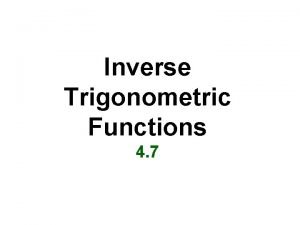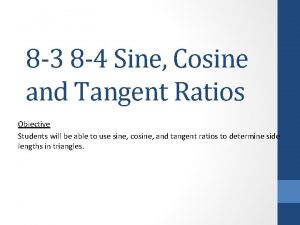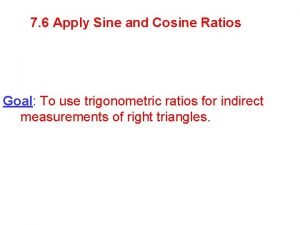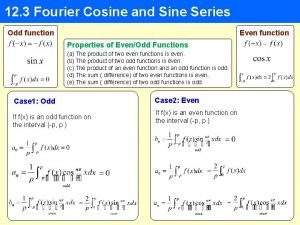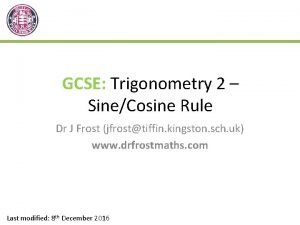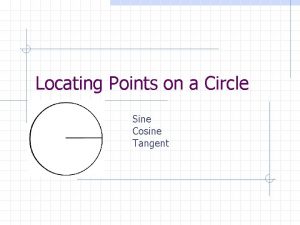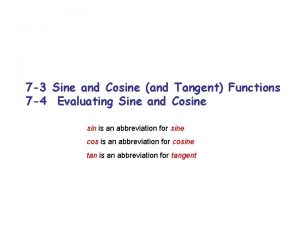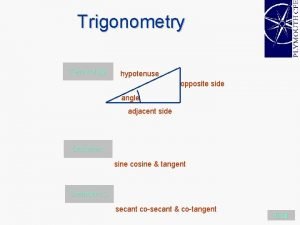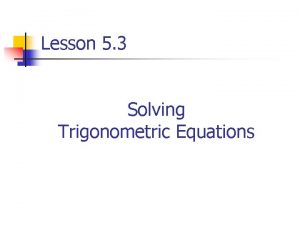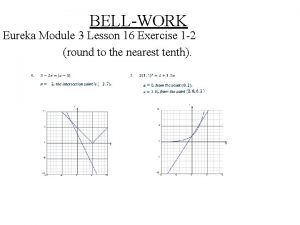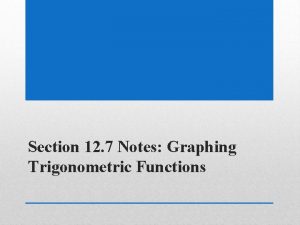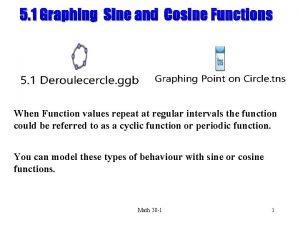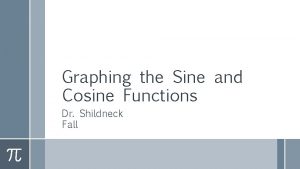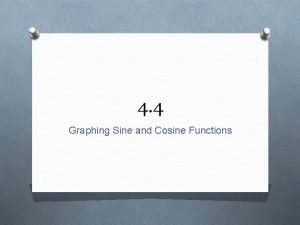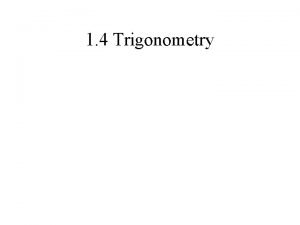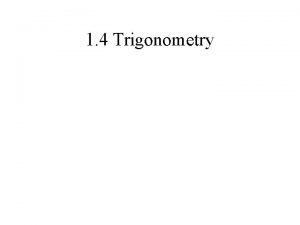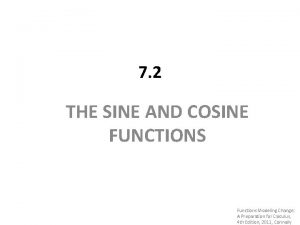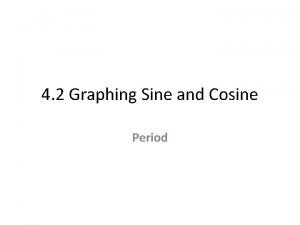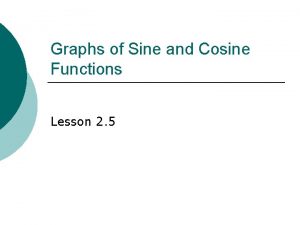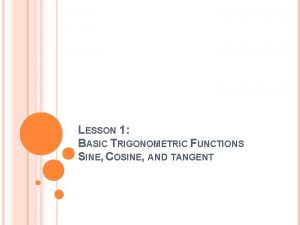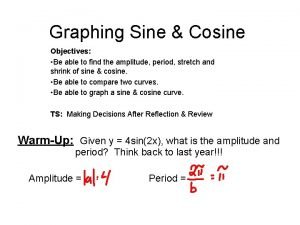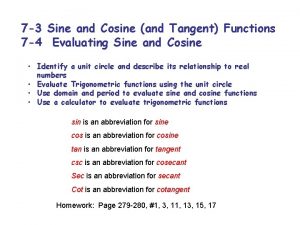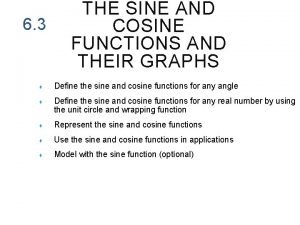LESSON 4 4 Graphing Sine and Cosine Functions



















































- Slides: 51

LESSON 4– 4 Graphing Sine and Cosine Functions

Five-Minute Check (over Lesson 4 -3) TEKS Then/Now New Vocabulary Key Concept: Properties of the Sine and Cosine Functions Key Concept: Amplitudes of Sine and Cosine Functions Example 1: Graph Vertical Dilations of Sinusoidal Functions Example 2: Graph Reflections of Sinusoidal Functions Key Concept: Example 3: Graph Horizontal Dilations of Sinusoidal Functions Key Concept: Example 4: Frequency of Sine and Cosine Functions Real-World Example: Use Frequency to Write a Sinusoidal Function Key Concept: Example 5: Periods of Sine and Cosine Functions Phase Shift of Sine and Cosine Functions Graph Horizontal Translations of Sinusoidal Functions Example 6: Graph Vertical Translations of Sinusoidal Functions Concept Summary: Graphs of Sinusoidal Functions Example 7: Real-World Example: Modeling Data Using a Sinusoidal Function

Over Lesson 4 -3 Let (– 5, 12) be a point on the terminal side of an angle θ in standard position. Find the exact values of the six trigonometric functions of θ. A. B. C. D.

Over Lesson 4 -3 Find the exact value of cot 3π, if defined. If not defined, write undefined. A. 0 B. 1 C. – 1 D. undefined

Over Lesson 4 -3 Find the exact value of csc 210º. A. – 2 B. C. D. 2

Over Lesson 4 -3 Find the exact value of A. B. C. D. .

Over Lesson 4 -3 Let , where cos θ < 0. Find the exact values of the five remaining trigonometric functions of θ. A. B. C. D.

Over Lesson 4 -3 Find the exact value of tan A. B. C. D. .

Targeted TEKS P. 2(F) Graph exponential logarithmic rational, polynomial, power, trigonometric, inverse trigonometric, and piecewise defined functions, including step functions. P. 2(G) Graph functions, including exponential, logarithmic, sine, cosine, rational, polynomial, and power functions and their transformations, including af(x), f(x) + d, f(bx), and f(x – c) for specific positive and negative values of a, b, c, and d, in mathematical and real-world problems. Also addresses P. 2(I), P. 2(O), and P. 4(F). Mathematical Processes P. 1(B), P. 1(D)

You analyzed graphs of functions. (Lesson 1 -5) • Graph transformations of the sine and cosine functions. • Use sinusoidal functions to solve problems.

• sinusoid • amplitude • frequency • phase shift • vertical shift • midline



Graph Vertical Dilations of Sinusoidal Functions Describe how the graphs of f (x) = sin x and g (x) = 2. 5 sin x are related. Then find the amplitude of g (x), and sketch two periods of both functions on the same coordinate axes. The graph of g (x) is the graph of f (x) expanded vertically. The amplitude of g (x) is |2. 5| or 2. 5.

Graph Vertical Dilations of Sinusoidal Functions Create a table listing the coordinates of the x-intercepts and extrema for f (x) = sin x for one period on [0, 2π]. Then use the amplitude of g (x) to find corresponding points on its graph.

Graph Vertical Dilations of Sinusoidal Functions Sketch the curve through the indicated points for each function. Then repeat the pattern suggested by one period of each graph to complete a second period on [2π, 4π]. Extend each curve to the left and right to indicate that the curve continues in both directions.

Graph Vertical Dilations of Sinusoidal Functions Answer: The graph of g (x) is the graph of f (x) expanded vertically. The amplitude of g (x) is 2. 5.

Describe how the graphs of f (x) = cos x and g (x) = 5 cos x are related. A. The graph of g (x) is the graph of f (x) compressed horizontally. B. The graph of g (x) is the graph of f (x) compressed vertically. C. The graph of g (x) is the graph of f (x) expanded horizontally. D. The graph of g (x) is the graph of f (x) expanded vertically.

Graph Reflections of Sinusoidal Functions Describe how the graphs of f (x) = cos x and g (x) = – 2 cos x are related. Then find the amplitude of g (x), and sketch two periods of both functions on the same coordinate axes. The graph of g (x) is the graph of f (x) expanded vertically and then reflected in the x-axis. The amplitude of g (x) is |– 2| or 2.

Graph Reflections of Sinusoidal Functions Create a table listing the coordinates of key points of f (x) = cos x for one period on [0, 2π]. Use the amplitude of g (x) to find corresponding points on the graph of y = 2 cos x. Then reflect these points in the x-axis to find corresponding points on the graph of g (x).

Graph Reflections of Sinusoidal Functions Sketch the curve through the indicated points for each function. Then repeat the pattern suggested by one period of each graph to complete a second period on [2π, 4π]. Extend each curve to the left and right to indicate that the curve continues in both directions.

Graph Reflections of Sinusoidal Functions Answer: The graph of g (x) is the graph of f (x) expanded vertically and then reflected in the x-axis. The amplitude of g (x) is 2.

Describe how the graphs of f (x) = cos x and g (x) = – 6 cos x are related. A. The graph of g (x) is the graph of f (x) expanded horizontally and then reflected in the y-axis. B. The graph of g (x) is the graph of f (x) expanded vertically and then reflected in the x-axis. C. The graph of g (x) is the graph of f (x) expanded horizontally and then reflected in the x-axis. D. The graph of g (x) is the graph of f (x) expanded vertically and then reflected in the y-axis.


Graph Horizontal Dilations of Sinusoidal Functions Describe how the graphs of f (x) = cos x and g (x) = cos are related. Then find the period of g (x), and sketch at least one period of both functions on the same coordinate axes. Because cos = cos , the graph of g (x) is the graph of f(x) expanded horizontally. The period of g (x) is

Graph Horizontal Dilations of Sinusoidal Functions Because the period of g (x) is 16π, to find corresponding points on the graph of g (x), change the x-coordinates of those key points on f (x) so that they range from 0 to 16π, increasing by increments of

Graph Horizontal Dilations of Sinusoidal Functions Sketch the curve through the indicated points for each function, continuing the patterns to complete one full cycle of each.

Graph Horizontal Dilations of Sinusoidal Functions Answer: The graph of g (x) is the graph of f (x) expanded horizontally by a factor of 8. The period of g (x) is 16π.

Describe how the graphs of f (x) = sin x and g (x) = sin 4 x are related. A. The graph of g(x) is the graph of f(x) expanded vertically. B. The graph of g(x) is the graph of f(x) expanded horizontally. C. The graph of g(x) is the graph of f(x) compressed vertically. D. The graph of g(x) is the graph of f(x) compressed horizontally.


Use Frequency to Write a Sinusoidal Function MUSIC A bass tuba can hit a note with a frequency of 50 cycles per second (50 hertz) and an amplitude of 0. 75. Write an equation for a cosine function that can be used to model the initial behavior of the sound wave associated with the note. The general form of the equation will be y = a cos bt, where t is the time in seconds. Because the amplitude is 0. 75, |a| = 0. 75. This means that a = ± 0. 75. The period is the reciprocal of the frequency or Use this value to find b. .

Use Frequency to Write a Sinusoidal Function Period formula period = |b| = 2π(50) or 100π Solve for |b|. Solve for b. By arbitrarily choosing the positive values of a and b, one cosine function that models the initial behavior is y = 0. 75 cos 100πt. Answer: Sample answer: y = 0. 75 cos 100πt

MUSIC In the equal tempered scale, F sharp has a frequency of 740 hertz. Write an equation for a sine function that can be used to model the initial behavior of the sound wave associated with F sharp having an amplitude of 0. 2. A. y = 0. 2 sin 1480πt B. y = 0. 2 sin 740πt C. y = 0. 4 sin 370πt D. y = 0. 1 sin 74πt


Graph Horizontal Translations of Sinusoidal Functions State the amplitude, period, frequency, and phase shift of . Then graph two periods of the function. In this function, a = 2, b = 5, and c = Amplitude: |a| = |2| or 2 Frequency: Period: .

Graph Horizontal Translations of Sinusoidal Functions Phase shift: To graph , consider the graph of y = 2 sin 5 x. The period of this function is . Create a table listing the coordinates of key points of y = 2 sin 5 x on the interval for a phase shift of , subtract . To account from the x-values of each of the key points for the graph of y = 2 sin 5 x.

Graph Horizontal Translations of Sinusoidal Functions Sketch the graph of y = 2 sin through these points, continuing the pattern to complete two cycles.

Graph Horizontal Translations of Sinusoidal Functions Answer: amplitude = 2; period = frequency = ; ; phase shift =

State the amplitude, period, frequency, and phase shift of y = 4 cos A. amplitude: 4, period: , frequency: , phase shift: B. amplitude: , period: 3, frequency: , phase shift: C. amplitude: 4, period: 6π, frequency: D. amplitude: – 4, period: , frequency: , phase shift:

Graph Vertical Translations of Sinusoidal Functions State the amplitude, period, frequency, phase shift, and vertical shift of y = sin (x + π) + 1. Then graph two periods of the function. In this function, a = 1, b = 1, c = π, and d = 1. Amplitude: |a| = | 1 | or 1 Period: Frequency: Phase shift: Vertical shift: d or 1 Midline: y = d or y = 1

Graph Vertical Translations of Sinusoidal Functions Answer: amplitude = 1; period = 2π; frequency = phase shift = –π; vertical shift = 1 ;

State the amplitude, period, frequency, phase shift, and vertical shift of . A. amplitude: 3, period: vertical shift: 2 , frequency: , phase shift: , B. amplitude: – 3, period: vertical shift: – 2 , frequency: C. amplitude: 3, period: vertical shift: 2 , frequency: , phase shift: , D. amplitude: 3, period: vertical shift: – 2 , frequency: , , phase shift: ,


Modeling Data Using a Sinusoidal Function METEOROLOGY The tides in the Bay of Fundy, in New Brunswick, Canada, have extreme highs and lows everyday. The table shows the high tides for one lunar month. Write a trigonometric function that models the height of the tides as a function of time x, where x = 1 represents the first day of the month.

Modeling Data Using a Sinusoidal Function Step 1 Make a scatter plot of the data and choose a model. The graph appears wave-like, so you can use a sinusoidal function of the form y = a sin (bx + c) + d or y = a cos (bx + c) + d to model the data. We will choose to use y = a cos (bx + c) + d to model the data.

Modeling Data Using a Sinusoidal Function Step 2 Find the maximum M and minimum m values of the data, and use these values to find a, b, c, and d. The maximum and minimum heights are 28. 0 and 23. 3, respectively. The amplitude a is half of the distance between the extrema. a= The vertical shift d is the average of the maximum and minimum data values.

Modeling Data Using a Sinusoidal Function A sinusoid completes half of a period in the time it takes to go from its maximum to its minimum value. One period is twice this time. Period = 2(xmax – xmin) = 2(17 – 10) or 14 xmax = day 17 and xmin = day 10 Because the period equals write |b| = , you can Therefore, | b | =

Modeling Data Using a Sinusoidal Function The maximum data value occurs when x = 17. Since y = cos x attains its first maximum when x = 0, we must apply a phase shift of 17 – 0 or 17 units. Use this value to find c. Phase shift formula Phase shift = 17 and |b| = Solve for c.

Modeling Data Using a Sinusoidal Function Step 3 Write the function using the values for a, b, c, and d. Use b =. y = 2. 35 cos model for the height of the tides. Answer: is one

TEMPERATURES The table shows the average monthly high temperatures for Chicago. Write a function that models the high temperatures using x = 1 to represent January. A. B. C. D.

LESSON 4– 4 Graphing Sine and Cosine Functions
 4-4 graphing sine and cosine functions worksheet answers
4-4 graphing sine and cosine functions worksheet answers Graphing sine and cosine quiz
Graphing sine and cosine quiz Sine rule graph
Sine rule graph Graph of all trigonometric functions
Graph of all trigonometric functions How to find period of cosine function
How to find period of cosine function Horizontal phase shift
Horizontal phase shift Transformations of sine and cosine functions
Transformations of sine and cosine functions Sine and cosine graphs
Sine and cosine graphs Graph of sine and cosine functions
Graph of sine and cosine functions How to find the horizontal shift of a sine graph
How to find the horizontal shift of a sine graph Graph of sine and cosine functions
Graph of sine and cosine functions Transformations of sine and cosine functions
Transformations of sine and cosine functions Practice 9-2 sine and cosine ratios answer key
Practice 9-2 sine and cosine ratios answer key 8-4 trigonometry worksheet answers
8-4 trigonometry worksheet answers What is m<5
What is m<5 Sine maze
Sine maze Sohcahtoa practice
Sohcahtoa practice Sine law and cosine law
Sine law and cosine law Inverse sin graph
Inverse sin graph Sine cosine rule
Sine cosine rule Sine word problems
Sine word problems Practice 8-4 sine and cosine ratios geometry
Practice 8-4 sine and cosine ratios geometry Sine and cosine ratios
Sine and cosine ratios Fourier transform odd function
Fourier transform odd function Sine and cosine transformations
Sine and cosine transformations Doctor frost answers
Doctor frost answers The sine and cosine curves intersect infinitely
The sine and cosine curves intersect infinitely Sin = adjacent or opposite
Sin = adjacent or opposite Sin cos tan
Sin cos tan Half range cosine series
Half range cosine series Magic trig triangles
Magic trig triangles Sine cosine tangent circle
Sine cosine tangent circle Sin quadrants
Sin quadrants Hypotenuse/opposite
Hypotenuse/opposite Chesmore vs richards
Chesmore vs richards 3-4 graphing functions
3-4 graphing functions Lesson 5-2 graphing polynomial functions answers
Lesson 5-2 graphing polynomial functions answers Nullum crimen sine lege nulla poena sine lege
Nullum crimen sine lege nulla poena sine lege Nullum crimen sine lege nulla poena sine lege
Nullum crimen sine lege nulla poena sine lege Trig equation solver with steps
Trig equation solver with steps Cos90
Cos90 Graphing square and cube root functions
Graphing square and cube root functions Cotangent graphs
Cotangent graphs Graphing linear and exponential functions
Graphing linear and exponential functions Solving graphing and analyzing quadratic functions
Solving graphing and analyzing quadratic functions Lesson 7 - graphing radical equations and inequalities
Lesson 7 - graphing radical equations and inequalities 5-6 graphing inequalities in two variables answer key
5-6 graphing inequalities in two variables answer key Lesson 16 solving and graphing inequalities
Lesson 16 solving and graphing inequalities Absolute value lesson 1-3
Absolute value lesson 1-3 7-1 graphing exponential functions
7-1 graphing exponential functions Unit 5: polynomial functions homework 3
Unit 5: polynomial functions homework 3 12-7 graphing trigonometric functions answers
12-7 graphing trigonometric functions answers

